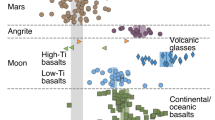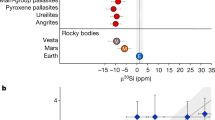Abstract
Magmatic iron meteorites are thought to originate from the cores of differentiated planetary embryos, but it is unclear where they formed in the circumstellar disk. Oxygen fugacity (fO2) is thought to have varied radially across the disk, affecting planetary accretion and core formation. Metal–silicate equilibration experiments show that the chromium concentration in metallic melt increases with decreasing fO2. Chromium can therefore be used to reconstruct fO2 during metal segregation. Here, we report mass-dependent fractionation of stable chromium isotopes measured for several groups of magmatic iron meteorites. We find that chromium concentrations are variable and most samples are isotopically heavy compared with the bulk silicate Earth and chondrites. Although it is evident that the chromium isotopes were systematically affected by fractional crystallization, we use the mass-dependent fractionation behaviour to derive initial chromium concentrations for the planetary embryo cores. We find that the cores were diverse in fO2 and demonstrate that core formation in some planetary embryos occurred under relatively oxidizing conditions (fO2 relative to iron–wüstite (IW) buffer (ΔIW) = −0.95 ± 0.15). It is difficult to reconcile this with the view that iron meteorite parent bodies formed closer to Earth and subsequently migrated outwards. Instead, we suggest that these parent bodies formed at greater distances, beyond Mars.
This is a preview of subscription content, access via your institution
Access options
Access Nature and 54 other Nature Portfolio journals
Get Nature+, our best-value online-access subscription
$29.99 / 30 days
cancel any time
Subscribe to this journal
Receive 12 print issues and online access
$259.00 per year
only $21.58 per issue
Buy this article
- Purchase on Springer Link
- Instant access to full article PDF
Prices may be subject to local taxes which are calculated during checkout



Similar content being viewed by others
References
Newsom, H. E. in Origin of the Earth (eds Newsom, H. E. & Jones, J. H.) 273–288 (Oxford Univ. Press, New York, 1990).
Wood, B. J., Wade, J. & Kilburn, M. R. Core formation and the oxidation state of the Earth: additional constraints from Nb, V and Cr partitioning. Geochim. Cosmochim. Acta 72, 1415–1426 (2008).
Brett, R. & Sato, M. Intrinsic oxygen fugacity measurements on 7 chondrites, a pallasite and a tektite and the redox state of the meteorite parent bodies. Geochim. Cosmochim. Acta 48, 111–120 (1984).
Cartier, C. et al. Experimental study of trace element partitioning between enstatite and melt in enstatite chondrites at low oxygen fugacities and 5 GPa. Geochim. Cosmochim. Acta 130, 167–187 (2014).
Bottke, W., Nesvorny, D., Grimm, R., Morbidelli, A. & O’Brien, D. Iron meteorites as remnants of planetesimals formed in the terrestrial planet region. Nature 439, 821–824 (2006).
Kruijer, T. S., Burkhardt, C., Budde, G. & Kleine, T. Age of Jupiter inferred from the distinct genetics and formation times of meteorites. Proc. Natl Acad. Sci. USA 114, 6712–6716 (2017).
Allègre, C., Poirier, J., Humler, E. & Hofmann, A. The chemical composition of the Earth. Earth Planet. Sci. Lett. 134, 515–526 (1995).
McDonough, W. & Sun, S. The composition of the Earth. Chem. Geol. 120, 223–253 (1995).
Gessmann, C. & Rubie, D. The origin of the depletions of V, Cr and Mn in the mantles of the Earth and Moon. Earth Planet. Sci. Lett. 184, 95–107 (2000).
Righter, K. Prediction of metal–silicate partition coefficients for siderophile elements: an update and assessment of PT conditions for metal–silicate equilibrium during accretion of the Earth. Earth Planet. Sci. Lett. 304, 158–167 (2011).
Siebert, J., Corgne, A. & Ryerson, F. J. Systematics of metal–silicate partitioning for many siderophile elements applied to Earth’s core formation. Geochim. Cosmochim. Acta 75, 1451–1489 (2011).
Tuff, J., Wood, B. J. & Wade, J. The effect of Si on metal–silicate partitioning of siderophile elements and implications for the conditions of core formation. Geochim. Cosmochim. Acta 75, 673–690 (2011).
Fischer, R. A. et al. High pressure metal–silicate partitioning of Ni, Co, V, Cr, Si, and O. Geochim. Cosmochim. Acta 167, 177–194 (2015).
Clesi, V. et al. Effect of H2O on metal–silicate partitioning of Ni, Co, V, Cr, Mn and Fe: implications for the oxidation state of the Earth. Geochim. Cosmochim. Acta 192, 97–121 (2016).
Goldstein, J. I., Scott, E. R. D. & Chabot, N. L. Iron meteorites: crystallization, thermal history, parent bodies, and origin. Chem. Erde Geochem. 69, 293–325 (2009).
Chabot, N. L., Saslow, S. A., McDonough, W. F. & Jones, J. H. An investigation of the behavior of Cu and Cr during iron meteorite crystallization. Meteorit. Planet. Sci. 44, 505–519 (2009).
Wasson, J. Trapped melt in IIIAB irons; solid/liquid elemental partitioning during the fractionation of the IIIAB magma. Geochim. Cosmochim. Acta 63, 2875–2889 (1999).
Wasson, J. & Richardson, J. Fractionation trends among IVA iron meteorites: contrasts with IIIAB trends. Geochim. Cosmochim. Acta 65, 951–970 (2001).
Wasson, J. T., Huber, H. & Malvin, D. J. Formation of IIAB iron meteorites. Geochim. Cosmochim. Acta 71, 760–781 (2007).
Williams, H. M. et al. Fe isotope fractionation in iron meteorites: new insights into metal–sulphide segregation and planetary accretion. Earth Planet. Sci. Lett. 250, 486–500 (2006).
Bridgestock, L. J. et al. Unlocking the zinc isotope systematics of iron meteorites. Earth Planet. Sci. Lett. 400, 153–164 (2014).
Bishop, M. C. et al. The Cu isotopic composition of iron meteorites. Meteorit. Planet. Sci. 47, 268–276 (2012).
Cook, D. L. et al. Mass-dependent fractionation of nickel isotopes in meteoritic metal. Meteorit. Planet. Sci. 42, 2067–2077 (2007).
Gall, L., Williams, H. M., Halliday, A. N. & Kerr, A. C. Nickel isotopic composition of the mantle. Geochim. Cosmochim. Acta 199, 196–209 (2017).
Ellis, A. S., Johnson, T. M. & Bullen, T. D. Chromium isotopes and the fate of hexavalent chromium in the environment. Science 295, 2060–2062 (2002).
Schoenberg, R., Zink, S., Staubwasser, M. & von Blanckenburg, F. The stable Cr isotope inventory of solid Earth reservoirs determined by double spike MC-ICP-MS. Chem. Geol. 249, 294–306 (2008).
Xia, J. et al. Chromium isotope heterogeneity in the mantle. Earth Planet. Sci. Lett. 464, 103–115 (2017).
Bonnand, P., Parkinson, I. J. & Anand, M. Mass dependent fractionation of stable chromium isotopes in mare basalts: implications for the formation and the differentiation of the Moon. Geochim. Cosmochim. Acta 175, 208–221 (2016).
Moynier, F., Yin, Q.-Z. & Schauble, E. Isotopic evidence of Cr partitioning into Earth’s core. Science 331, 1417–1420 (2011).
Schiller, M., Van Kooten, E., Holst, J. C., Olsen, M. B. & Bizzarro, M. Precise measurement of chromium isotopes by MC-ICP-MS. J. Anal. At. Spectrom. 29, 1406–1416 (2014).
Bonnand, P., Williams, H. M., Parkinson, I. J., Wood, B. J. & Halliday, A. N. Stable chromium isotopic composition of meteorites and metal–silicate experiments: implications for fractionation during core formation. Earth Planet. Sci. Lett. 435, 14–21 (2016).
Schoenberg, R. et al. The stable Cr isotopic compositions of chondrites and silicate planetary reservoirs. Geochim. Cosmochim. Acta 183, 14–30 (2016).
Birck, J.-L. & Allègre, C. J. in Isotopic Ratios in the Solar System 21–25 (Cepadues-Editions, Toulouse,1985).
Shima, M. & Honda, M. Distribution of spallation produced chromium between alloys in iron meteorites. Earth Planet. Sci. Lett. 1, 65–74 (1966).
Qin, L., Alexander, C. M. O., Carlson, R. W., Horan, M. F. & Yokoyama, T. Contributors to chromium isotope variation of meteorites. Geochim. Cosmochim. Acta 74, 1122–1145 (2010).
Clayton, R. & Mayeda, T. Oxygen isotope studies of achondrites. Geochim. Cosmochim. Acta 60, 1999–2017 (1996).
Trinquier, A., Birck, J.-L. & Allegre, C. J. Widespread Cr-54 heterogeneity in the inner solar system. Astrophys. J. 655, 1179–1185 (2007).
Wasson, J., Lange, D., Francis, C. & Ulff-Moller, F. Massive chromite in the Brenham pallasite and the fractionation of Cr during the crystallization of asteroidal cores. Geochim. Cosmochim. Acta 63, 1219–1232 (1999).
Isa, J., Ma, C. & Rubin, A. E. Joegoldsteinite: a new sulfide mineral (MnCr2S4) from the Social Circle IVA iron meteorite. Am. Mineral. 101, 1217–1221 (2016).
Farkas, J. et al. Chromium isotope variations (δ53/52Cr) in mantle-derived sources and their weathering products: implications for environmental studies and the evolution of δ53/52Cr in the Earth’s mantle over geologic time. Geochim. Cosmochim. Acta 123, 74–92 (2013).
Bonnand, P., James, R. H., Parkinson, I. J., Connelly, D. P. & Fairchild, I. J. The chromium isotopic composition of seawater and marine carbonates. Earth Planet. Sci. Lett. 382, 10–20 (2013).
Shields, W., Murphy, T., Catanzaro, E. & Garner, E. Absolute isotopic abundance ratios and atomic weight of a reference sample of chromium. J. Res. NBS A Phys. Chem. 70, 193–197 (1966).
Bonnand, P., Parkinson, I. J., James, R. H., Karjalainen, A.-M. & Fehr, M. A. Accurate and precise determination of stable Cr isotope compositions in carbonates by double spike MC-ICP-MS. J. Anal. At. Spectrom. 26, 528–535 (2011).
Acknowledgements
This research was supported by STFC grant ST/M001318/1. We thank M. Boyet and A. Bouhifd for commenting on an earlier version of the manuscript. We also thank the Natural History Museum (London) and Smithsonian for access to samples.
Author information
Authors and Affiliations
Contributions
P.B. performed all the measurements. P.B. and A.N.H. wrote the manuscript.
Corresponding author
Ethics declarations
Competing interests
The authors declare no competing interests.
Additional information
Publisher’s note: Springer Nature remains neutral with regard to jurisdictional claims in published maps and institutional affiliations.
Supplementary information
Supplementary Information
Supplementary Data and Figures
Rights and permissions
About this article
Cite this article
Bonnand, P., Halliday, A.N. Oxidized conditions in iron meteorite parent bodies. Nature Geosci 11, 401–404 (2018). https://doi.org/10.1038/s41561-018-0128-2
Received:
Accepted:
Published:
Issue Date:
DOI: https://doi.org/10.1038/s41561-018-0128-2
This article is cited by
-
Accretion of the earliest inner Solar System planetesimals beyond the water snowline
Nature Astronomy (2024)
-
Correlated iron isotopes and silicon contents in aubrite metals reveal structure of their asteroidal parent body
Scientific Reports (2021)



